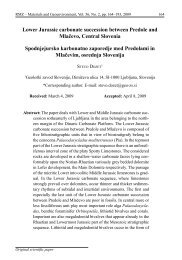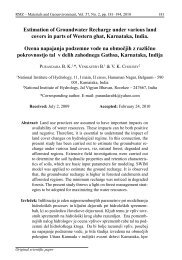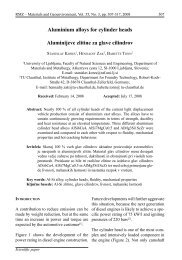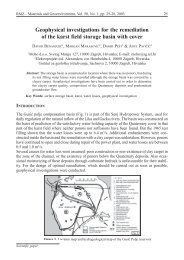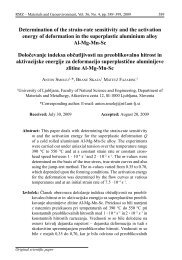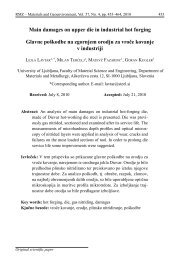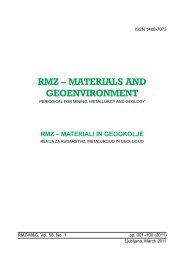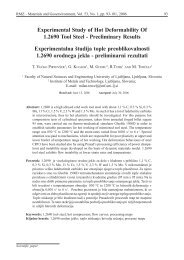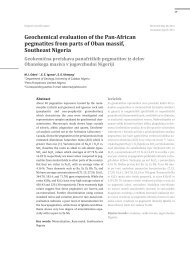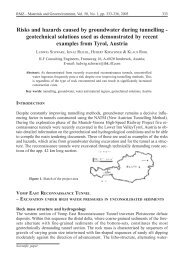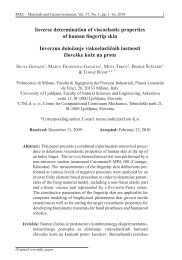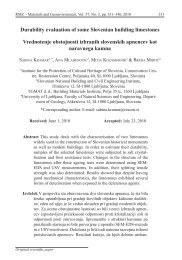430 Kos, A., Dervarič, E.novega verižnega zasekovalnega stroja pri pridobivanju naravnegakamna – apnenca v kamnolomih družbe Marmor, Sežana, d. d.Key words: underground excavation of natural stone, geological studies,mineral raw materials, chain saw machinesKljučne besede: podzemno pridobivanje naravnega kamna, geološkeraziskave, mineralne surovine, verižne žageIntroductionNatural stone used for constructionpurposes are the rocks whose colour,compactness or other properties areappealing to a human eye. They wereused by old civilisations to glorify theirmonarchs or even to make them equalto gods. It is precisely the use of stonethat made it possible for many greatachievements of the past to remain preserveduntil today.A special and distinctive feature of naturalstone is its hardness, stability andits possibility of shaping. Natural stoneis unique and exceptional in itself, asits colours and structure are very differentand dependent of the nature.Beside physical and mechanical propertiesof stone, the excavation methodis also influenced by mining and geologicalconditions as well as technicalconditions of excavation. Judging fromexperience, the most problems in naturalstone excavation are caused by tectonicinfluences, mainly cracking andfragmentation which, together withstratification and karstification, usuallysignificantly reduce the yield or evenprevent further excavation of blocks ofnatural stone.Additionally, the excavation processesand the final yield in a quarry are mostlyinfluenced by the excavation method,the use of suitable equipment andutilisation of natural features of stone.Development of quarry equipmentNatural stone is undoubtedly the materialthat has been used by man throughoutthe entire history. The prehistoricman exploited the stone by collectingit from the ground or breaking and diggingto the depth or size easily liftedand transported. The stone was processedby means of stone and woodentools. After discovery of metals, metaltools were used for stone processing.The man used stone for tools andweapons in the struggle against natureand for construction purposes. Beautifulstone blocks were used for makingmonuments, doorposts, portals, etc.The material was transported by oxen,horses, etc. [5]<strong>RMZ</strong>-M&G 2012, 59
Izbira tehnološkega procesa in opreme za pridobivanje naravnega kamna ...431Until a few decades ago, the exploitationof stone was based on makinguse of its natural properties, mainlythe cracks which were used for breakingthe stone into smaller pieces. Allworks were done on the surface,manually, with primitive tools suchas mallets, chisels, picks and varioussimple levers. The pieces of stoneappearing on the surface were carvedby picks and mallets until they broke.The work was long-lasting and strenuous.A true revolution in the quarry workwas brought about by boring drills. Thework was still manual. Natural featuresof sites were exploited. In winter, peoplepoured water in cracks. Freezingwater expanded the cracks and madebreaking of stone easier. Hazelnut rodsand oak wedges were also used; theywere hammered into cracks and moistenedwith water. [2]The development of pneumatic drillingtools additionally changed andincreased the production. Using pneumaticdrilling equipment, people drilledunder and around the rock mass whichwas then split into smaller blocks bymeans of wedges and heavy mallets. Inmost cases, they made use of naturalfeatures of the sites (discontinuities,stratification, etc.), but they also usedvarious emulsions, gunpowder anddetonating cord to split the rock massapart. [3]The development of quarry equipmentcontinued with helicoid wireand quartz sand. This method was firstused in the year 1854. In our country,it continued to be used by mid-1980s.At cutting sites, vertical bores with adiameter of 240 mm and 360 mm andhorizontal bores with a diameter of 90mm were first drilled. A 5.8 mm helicoidwire was threaded through thebores and used, together with quartzsand, for cutting of stone. An engineroom with a diesel aggregate was requiredfor the start-up. Water was usedas an additive and a coolant. The cuttingefficiency was low, amounting to1.5 m 2 /h to 2.0 m 2 /h, depending on thehardness of the stone. The length of thewire system line was sometimes up to2.5 km. [2] In the present time, helicoidwire has been replaced by diamondwire.A new revolution in quarry mining wasintroduction of diamond wire saw. Thefirst diamond wire saws came into operationin the 1970s. The cutting processis similar to the preceding technology;i.e. a combined method withpreviously drilled bores (34–90 mm indiameter) and diamond wire saw. Thespeed of cutting ranged from 8 m 2 /h to12 m 2 /h, which meant new possibilitiesin exploitation and processing of naturalstone. In the beginning, diamondwire saws with 30 kW (40 hp) motorswere used, which allowed cuttingof surfaces of up to 150 m 2 . [2] Today,<strong>RMZ</strong>-M&G 2012, 59
- Page 4 and 5:
IVTable of Contents - KazaloProfess
- Page 7 and 8:
Calculation of stress-strain depend
- Page 9 and 10:
Calculation of stress-strain depend
- Page 11 and 12:
() = (, )() () ()Calculation
- Page 13 and 14:
, ) (, )(, ) 1 () + = (, ) =
- Page 15 and 16:
Calculation of stress-strain depend
- Page 17 and 18:
Calculation of stress-strain depend
- Page 19 and 20:
Calculation of stress-strain depend
- Page 21 and 22:
RMZ - Materials and Geoenvironment,
- Page 23 and 24:
Petrochemical characteristics and g
- Page 25 and 26:
Petrochemical characteristics and g
- Page 27 and 28:
Petrochemical characteristics and g
- Page 29 and 30:
Petrochemical characteristics and g
- Page 31 and 32:
Petrochemical characteristics and g
- Page 34 and 35:
360 Akinola, O. O., Talabi, A. O.A
- Page 36 and 37:
362 Akinola, O. O., Talabi, A. O.of
- Page 38 and 39:
364 Sunmonu, L. A., Adagunodo, T. A
- Page 40 and 41:
366 Sunmonu, L. A., Adagunodo, T. A
- Page 42 and 43:
368 Sunmonu, L. A., Adagunodo, T. A
- Page 44 and 45:
370 Sunmonu, L. A., Adagunodo, T. A
- Page 46 and 47:
372 Sunmonu, L. A., Adagunodo, T. A
- Page 48 and 49:
374 Sunmonu, L. A., Adagunodo, T. A
- Page 50 and 51:
376 Sunmonu, L. A., Adagunodo, T. A
- Page 52 and 53:
378 Sunmonu, L. A., Adagunodo, T. A
- Page 54 and 55: 380 Sunmonu, L. A., Adagunodo, T. A
- Page 56 and 57: 382 Sunmonu, L. A., Adagunodo, T. A
- Page 58 and 59: 384 Sunmonu, L. A., Adagunodo, T. A
- Page 60 and 61: 386 Sunmonu, L. A., Adagunodo, T. A
- Page 62 and 63: 388 Sunmonu, L. A., Adagunodo, T. A
- Page 64 and 65: 390 Sunmonu, L. A., Adagunodo, T. A
- Page 66 and 67: 392 Shemetov, P. A., Bibik, I. P.in
- Page 68 and 69: 394 Shemetov, P. A., Bibik, I. P.
- Page 70 and 71: k =1.05+Dλ = 1+k =( s )396 Shemeto
- Page 72 and 73: 398 Shemetov, P. A., Bibik, I. P.si
- Page 74 and 75: у 3 b400 D = f eShemetov, P. A., B
- Page 76 and 77: V4BEK Q σBEad = ,commQрσV 01 +
- Page 78 and 79: 404 Shemetov, P. A., Bibik, I. P.wh
- Page 80 and 81: thrмR iλ = 2 λ= 100⋅exp[ −(
- Page 82 and 83: qLevel of average technical (theore
- Page 84 and 85: .6670.05=0.35k1,05+D avet( s3≥ Kt
- Page 86 and 87: RMZ-M&G 2012, 59
- Page 88 and 89: 414 Adewale, A., Olawale, O. O., Ma
- Page 90 and 91: 416 Adewale, A., Olawale, O. O., Ma
- Page 92 and 93: 418 Adewale, A., Olawale, O. O., Ma
- Page 94 and 95: 420 Adewale, A., Olawale, O. O., Ma
- Page 96 and 97: 422 Adewale, A., Olawale, O. O., Ma
- Page 98 and 99: 424 Adewale, A., Olawale, O. O., Ma
- Page 100 and 101: 426 Adewale, A., Olawale, O. O., Ma
- Page 102 and 103: RMZ-M&G 2012, 59
- Page 106 and 107: 432 Kos, A., Dervarič, E.diamond w
- Page 108 and 109: 434 Kos, A., Dervarič, E.chines to
- Page 110 and 111: 436 Kos, A., Dervarič, E.the best
- Page 112 and 113: 438 Kos, A., Dervarič, E.Before th
- Page 114 and 115: 440 Kos, A., Dervarič, E.nally to
- Page 116 and 117: RMZ-M&G 2012, 59
- Page 118 and 119: 444 Lajovic, A.disc brakes, further
- Page 120 and 121: 446 Lajovic, A.Slika 2. Izrez iz Si
- Page 122 and 123: 448 Lajovic, A.Livne lonce smo na n
- Page 124 and 125: 450 Lajovic, A.Ingersol pa je bil z
- Page 126 and 127: 452 Lajovic, A.Med delavci, ki so b
- Page 128 and 129: 454 Lajovic, A.imel vsak delavec na
- Page 130 and 131: 456 Lajovic, A.Slika 5. Izdelki Že
- Page 132 and 133: 458 Lajovic, A.pa se ni najbolje iz
- Page 134 and 135: 460 Lajovic, A.za delo. Promet na z
- Page 136 and 137: 462 Lajovic, A.Sredi osemdesetih le
- Page 138 and 139: 464 Lajovic, A.njem delu forme. Na
- Page 140 and 141: 466 Lajovic, A.Enourni film je mars
- Page 142 and 143: RMZ-M&G 2012, 59
- Page 144 and 145: 470 Medved, J., Rosina, A., Vončin
- Page 146 and 147: 472 Author’s IndexAuthor`s Index,
- Page 148 and 149: RMZ-M&G 2012, 59
- Page 150 and 151: Contents476Phase contrast method fo
- Page 152: Contents47859/4Calculation of stres
- Page 155 and 156:
Instructions to authors481Compositi
- Page 157 and 158:
Instructions to authors483NAVODILA
- Page 159 and 160:
Instructions to authors485Knjige:Ro
- Page 161 and 162:
Template487TEMPLATEThe title of the
- Page 163 and 164:
Template489References (Times New Ro
- Page 165 and 166:
Template491Obstajata dve sprejemlji



